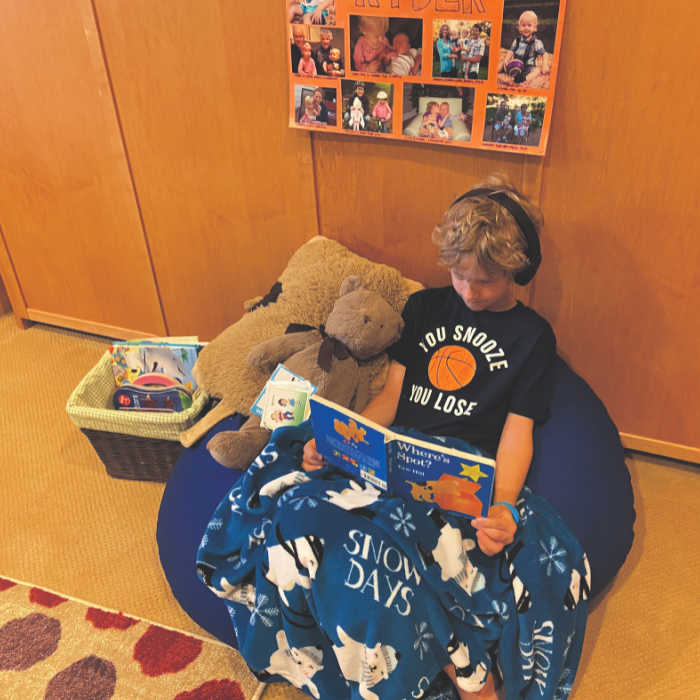Create Emotional Safe Space to Help Your Child Express Big Feelings
Creating an emotional safe space for your child can be a game changer when it comes to them expressing their big feelings in a positive way.
Toddlers and their temper tantrums seem to be a running joke over social media.
From memes to wine o’clock parenting, it’s easy to brush aside the real need toddlers and young children have in learning how to express big feelings.
Be sure to check out even more of my helpful parenting tips, too!
This post contains affiliate links.
Emotional Regulation Resources
Before we jump into how to create a safe space, it’s important to understand that toddlers can’t verbalize their emotions unless they know how to name them.
These emotional regulation and recognition resources will get you going:
The more we build tools to help our children control their reactions, the better they will be prepared to manage whatever comes their way.
Try fabulous tips on how to help kids understand their emotions!
With 9 hands-on activities and resources, your kids will learn all about naming their emotions.
This yoga and mindfulness bundle of resources enables you to add movement, play, and colorful stories to help you teach children about the importance of labeling, understanding, and embracing the big feelings they’re experiencing on a daily basis.
Full color photo emotion cards that will help expand your child’s emotional vocabulary beyond happy, mad, sad, and angry.
Create Emotional Safe Space to Help Your Child Express Their Big Feelings
While the outpouring of oversized emotions can be amusing when viewed from afar, most parents and caregivers simply want to know what they can do to help children express their feelings in less dramatic ways.
Emotional Literacy
According to child development experts, one of the keys to helping children learn to regulate their emotions is to develop emotional literacy – or the ability to identify feelings.
This can help children learn to recognize those feelings and apply coping strategies to (hopefully) calm down before their feelings overwhelm them.
One way to help children work on their emotional literacy is to talk about emotions other people feel.
“Sometimes it’s difficult to process our own emotions because that puts you in a vulnerable position,” said Taunya Banta from KinderCare’s Inclusion Services team.
“When we’re able to find some detachment from the immediate emotion, like talking about characters in a story – ‘How do you think they feel?’ or ‘Why do you think they feel that way?’ – it opens an opportunity for kids to safely process their own emotions because they’re not in the spotlight.”
Creating a Safe Space
Another way to help children work through their emotions before becoming overwhelmed is doing what many early childhood teachers do and create a space filled with things that allow children to find emotional release in a safe way.
If space allows, create both a quiet area and an active area.
Quiet Safe Space
Quiet areas allow children to work through their emotions using fine motor or listening skills.
My younger son really craved cuddly spaces – and still does to this day!
Items in this space could include blankets or pillows to cuddle up in or headphones to listen to relaxing music or audiobooks.
Some kids may find comfort in expressing their feelings through art, so consider including some drawing materials or a journal.
For young children, a set of pictures or cards showing faces expressing different emotions can help them as they learn to identify their own feelings.
You can even take your child’s small closet and turned it into a warm cozy nook!

Physical Outlet for Emotions
Active areas provide children opportunities to use their gross motor skills to work through emotions.
My first son really craved the physical emotional outlet when he was a toddler.
It really helped him stay emotionally balanced.
If outdoor space is easily accessible, encourage your children to go outside and jump, stomp or run when they start to feel the urge to “let it all out.”
An indoor active space could include pillows to scream into or hit and plastic bottles or bubble wrap to stomp on or squeeze.
The action and noise can help get out the desire to hit or punch.
Even jumping is an amazing sensory outlet that can help kids reset.
One mom swears by this sensory outlet for her kiddo.
Watch how your children show their emotions and give them safe alternatives.
For example, if they tend to yell and hit when they’re upset, give them pillows to scream into or hit.
You can also help them designate a box or a specific spot on the wall or floor that they can throw beanbags, wadded up socks or any soft object at.
Acknowledge the emotions your children are experiencing and reassure them that while it’s fine to feel that way, it’s just as important they find a safe outlet for their emotions.
For more tips to help children identify and regulate their emotions, visit KinderCare.com.





